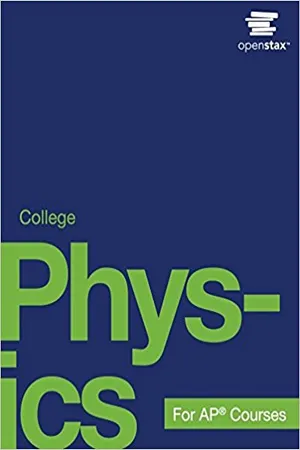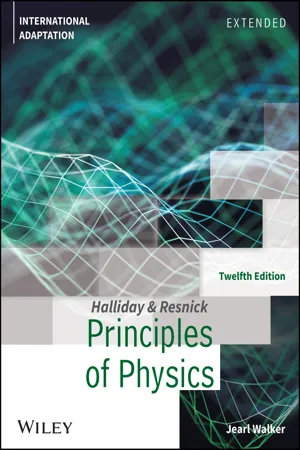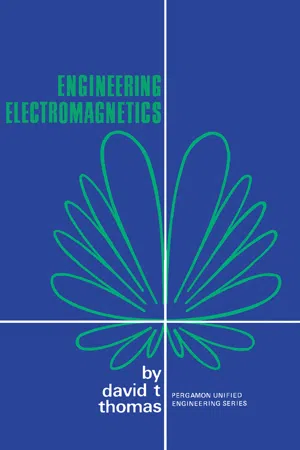Physics
Electric Field Between Two Parallel Plates
The electric field between two parallel plates is a uniform field that exists between the plates when a potential difference is applied across them. The field lines are straight and parallel, with the direction of the field pointing from the positive plate to the negative plate. The magnitude of the electric field is determined by the potential difference and the distance between the plates.
Written by Perlego with AI-assistance
Related key terms
1 of 5
8 Key excerpts on "Electric Field Between Two Parallel Plates"
- eBook - PDF
- Paul Peter Urone, Roger Hinrichs(Authors)
- 2012(Publication Date)
- Openstax(Publisher)
The potential difference between adjacent plates is not high enough to cause sparks without the ionization produced by particles from accelerator experiments (or cosmic rays). (credit: Daderot, Wikimedia Commons) Example 19.5 Field and Force inside an Electron Gun (a) An electron gun has parallel plates separated by 4.00 cm and gives electrons 25.0 keV of energy. What is the electric field strength between the plates? (b) What force would this field exert on a piece of plastic with a 0.500 μC charge that gets between the plates? Strategy Since the voltage and plate separation are given, the electric field strength can be calculated directly from the expression E = V AB d . Once the electric field strength is known, the force on a charge is found using F = q E . Since the electric field is in only one direction, we can write this equation in terms of the magnitudes, F = q E . Solution for (a) The expression for the magnitude of the electric field between two uniform metal plates is (19.31) E = V AB d . Since the electron is a single charge and is given 25.0 keV of energy, the potential difference must be 25.0 kV. Entering this value for V AB and the plate separation of 0.0400 m, we obtain (19.32) E = 25.0 kV 0.0400 m = 6.25×10 5 V/m. Solution for (b) The magnitude of the force on a charge in an electric field is obtained from the equation (19.33) F = qE. Substituting known values gives (19.34) F = (0.500×10 –6 C)(6.25×10 5 V/m) = 0.313 N. Discussion Note that the units are newtons, since 1 V/m = 1 N/C . The force on the charge is the same no matter where the charge is located between the plates. This is because the electric field is uniform between the plates. In more general situations, regardless of whether the electric field is uniform, it points in the direction of decreasing potential, because the force on a positive charge is in the direction of E and also in the direction of lower potential V . - eBook - PDF
- John D. Cutnell, Kenneth W. Johnson, David Young, Shane Stadler(Authors)
- 2015(Publication Date)
- Wiley(Publisher)
With the aid of integral calculus, this equation can be applied in a variety of situations where point charges are distributed over one or more surfaces. One such example that has considerable practical importance is the parallel plate capacitor. As Figure 18.21 shows, this device consists of two parallel metal plates, each with area A. A charge 1q is spread uniformly over one plate, while a charge 2q is spread uniformly over the other plate. In the region between the plates and away from the edges, the electric field points from the positive plate toward the negative plate and is perpendicular to both. It can be shown (see Example 15 in Section 18.9) that this electric field has a magnitude of Parallel plate capacitor E 5 q P 0 A 5 s P 0 (18.4) where P 0 is the permittivity of free space. In this expression the Greek symbol sigma (s) denotes the charge per unit area (s 5 q/A) and is sometimes called the charge density. Except in the region near the edges, the field has the same value at all places between the plates. The field does not depend on the distance from the charges, in distinct contrast to the field created by an isolated point charge. CONCEPTUAL EXAMPLE 11 | Symmetry and the Electric Field Four point charges all have the same magnitude, but they do not all have the same sign. These charges are fixed to the corners of a rectangle in two different ways, as Figure 18.20 shows. Con- sider the net electric field at the center C of the rectangle in each case. In which case, if either, is the net electric field greater? (a) It is greater in Figure 18.20a. (b) It is greater in Figure 18.20b. (c) The field has the same magnitude in both cases. Reasoning The net electric field at C is the vector sum of the individual fields created there by the charges at each corner. Each of the individual fields has the same magnitude, since the charges all have the same magnitude and are equidistant from C. The directions of the individual fields are different, however. - eBook - PDF
- John D. Cutnell, Kenneth W. Johnson, David Young, Shane Stadler(Authors)
- 2018(Publication Date)
- Wiley(Publisher)
It can be shown (see Example 15 in Section 18.9) that this electric field has a magnitude of Parallel plate capacitor E = q ε 0 A = σ ε 0 (18.4) where 0 is the permittivity of free space. In this expression the Greek symbol sigma () denotes the charge per unit area ( = q/A) and is sometimes called the charge density . Except in the + q – q Area = A E E + + + + + + + + + + + + + + + + + + + + – – – – – – – – – – – – – – – – – – – – E FIGURE 18.21 A parallel plate capacitor. 18.7 Electric Field Lines 505 region near the edges, the field has the same value at all places between the plates. The field does not depend on the distance from the charges, in distinct contrast to the field created by an isolated point charge. Check Your Understanding (The answers are given at the end of the book.) 11. There is an electric field at point P. A very small positive charge is placed at this point and experiences a force. Then the positive charge is replaced by a very small negative charge that has a magnitude dif- ferent from that of the positive charge. Which one of the following statements is true concerning the forces that these charges experience at P? (a) They are identical. (b) They have the same magnitude but different directions. (c) They have different magnitudes but the same direction. (d) They have different magnitudes and different directions. 12. Suppose that in Figure 18.20a point charges ‒q are fixed in place at corners 1 and 3 and point charges +q are fixed in place at corners 2 and 4. What then would be the net electric field at the center C of the rectangle? 13. A positive point charge +q is fixed in position at the center of a square, as CYU Figure 18.3 shows. A second point charge is fixed to corner B, C, or D. The net electric field that results at corner A is zero. - eBook - PDF
- M. Sibley(Author)
- 1995(Publication Date)
- Butterworth-Heinemann(Publisher)
We should thereforeexpectthat two chargedplates will exert a force on each other. To find this force, we couldadaptour model of fluxdistribution in a parallel plate capacitor, and then calculate the force betweenthe plates. However, thereis a simpler method. Let us consider theparallelplatecapacitorshown in Fig. 2.22.Thiscapacitor stores acertainamountof energy given by energy = ~ DE x area X 1 Now, therewill be a force ofattractionbetweenthe two plates. If we move the top plate by a small amount d1, we do work against theattractiveforce. As we are moving the top plate a very small amount, the E field will hardly vary. As the work done must equal the change in storedenergy, we can write, Fdl = ~DE X area X (1 + d1) -~DE x area X 1 = ~ DE X area X dl As D is the flux density,Equation(2.54) becomes, F = ~ IjJE or, F = ~ QE newton (2.55) where we have made use of Gauss' law. Dependingon theparticularapplica-tion, the forcebetween the two plates can be quite high. 2.9 Capacitors 49 Charged meta l iMm 2 IF Fig» 2,22 Fore© between two charged plates Force between chargei plates We have already seen that charges exert a force on each other. We have also seen that charged circular plates radiate electric lux in a cylinder. We shoul d therefore expec t that two charged plates will exert a force on each other. To find this force» we could adap t our mode l of flux distribution in a paralle l plate capacitor » and then calculat e the force between the plates . However» there is a simpler method , Let us conside r the paralle l plate capacito r shown in Fig, 2.22. This capacito r stores a certai n amoun t of energy given by energy = I DE X area X I Now, there will be a force of attraction between the two plates . If we move the top plate by a smal amoun t dl» we do work agains t the attractive force. As we are moving the top plate a very smal amount , the E field will hardly vary. - eBook - PDF
- John D. Cutnell, Kenneth W. Johnson, David Young, Shane Stadler(Authors)
- 2021(Publication Date)
- Wiley(Publisher)
For example, the electric field within the parallel plate capacitor in Figure 18.21 is produced by positive charges spread uni- formly over one plate and an equal number of negative charges spread over the other plate. As we will see, Gauss’ law describes the relationship between a charge distribution and the electric field it produces. This law was formulated by the German mathematician and physicist Carl Friedrich Gauss (1777–1855). In presenting Gauss’ law, it will be necessary to introduce a new idea called electric flux. The idea of flux involves both the electric field and the surface through which it passes. By bringing together the electric field and the surface through which it passes, we will be able to define electric flux and then present Gauss’ law. We begin by developing a version of Gauss’ law that applies only to a point charge, which we assume to be positive. The electric field lines for a positive point charge radiate outward in all directions from the charge, as Figure 18.22b indicates. The magnitude E of the electric field at a distance r from the charge is E = kq/r 2 , according to Equation 18.3, in which we have replaced the symbol ∣q∣ with the symbol q since we are assuming that the charge is positive. As mentioned in Section 18.5, the constant k can be expressed as k = 1/(4 0 ), where 0 is the permittivity of free space. With this substitution, the magnitude of the electric field becomes E = q/(4 0 r 2 ). We now place this point charge at the center of an imaginary spherical surface of radius r, as Figure 18.32 shows. Such a hypothetical closed surface is called a Gaussian surface, although in general it need not be spherical. - David Halliday, Robert Resnick, Jearl Walker(Authors)
- 2023(Publication Date)
- Wiley(Publisher)
If we place a positive test charge at any point near the sheet (on either side), we find that the electrostatic force on the particle is outward and perpendicular to the sheet. The perpendicular orientation is reasonable because any force com- ponent that is, say, upward is balanced out by an equal component that is down- ward. That leaves only outward, and thus the electric field vectors and the electric field lines must also be outward and perpendicular to the sheet, as shown in Figs. 22.1.4b and c. Because the charge on the sheet is uniform, the field vectors and the field lines are also. Such a field is a uniform electric field, meaning that the electric field has the same magnitude and direction at every point within the field. (This is a lot easier to work with than a nonuniform field, where there is variation from point to point.) Of course, there is no such thing as an infinitely large sheet. That is just a way of saying that we are measuring the field at points close to the sheet relative to the size of the sheet and that we are not near an edge. Figure 22.1.5 shows the field lines for two particles with equal positive charges. Now the field lines are curved, but the rules still hold: (1) The electric field vector at any given point must be tangent to the field line at that point and in the same direction, as shown for one vector, and (2) a closer spacing means electric field lines as in Fig. 22.1.3b. At any point, such as the one shown, the direction of the field line through the point matches the direction of the electric vector at that point. The rules for drawing electric fields lines are these: (1) At any point, the electric field vector must be tangent to the electric field line through that point and in the same direction.- eBook - PDF
Engineering Electromagnetics
Pergamon Unified Engineering Series
- David T. Thomas, Thomas F. Irvine, James P. Hartnett, William F. Hughes(Authors)
- 2013(Publication Date)
- Pergamon(Publisher)
The capacitance of this parallel plate capacitor is, (3.33) a formula I'm sure all of you find familiar. Also, on occasion you will see an edge correction term. This edge correction is merely the recalculation of the fields for finite, but large, plates and is an improvement over the assumption of infinite plates. Sheets of Charge In the problem of the parallel plate capacitor we found a uniformly distri-buted surface charge, p s , on each plate, where, The surface charge on the upper plate is positive, and the surface charge on the lower plate is negative. This configuration of charge is shown in Fig. 3-10 minus the plates and battery. Suppose we now apply Gauss's Law to this charge configuration to obtain the fields, disregarding the true source (battery) of the problem. If the fields pro-duced are identical to the fields of the original problem we can say the two sheets of charge are equivalent to the original sources and problem. Suppose first we consider only one sheet of charge, the positive sheet at y = d. The other sheet will be removed temporarily. To obtain the fields, we apply Gauss's Law, and as always we must make maximum use of symmetry. Due to the infinite geometry, there can be neither variation nor electric fields in the x and z directions. Also from symmetry, the fields on opposite sides of the sheet of charge are equal in magnitude, but pointing in opposite directions. Referring to The Parallel Plate Capacitor Fig. 3-10. Surface charges in parallel plate capacitor. Fig. 3-11 we apply Gauss's Law to the rectangular surface labelled b-b, and get On S u the surface normal, n l9 and the electric field, £ 13/ , are colinear so the inte-gral is positive. On S 2 the surface normal, n 29 and electric field, E 2y , are in opposite directions so the integral is negative. The net result is, We have already stipulated that E ly and E 2y are of equal magnitude, so that, (3.34) This is a very important result. - eBook - PDF
- John D. Cutnell, Kenneth W. Johnson, David Young, Shane Stadler(Authors)
- 2015(Publication Date)
- Wiley(Publisher)
But Q/A is the charge per unit area, s, on the plate. Therefore, we arrive at the value of the electric field inside a parallel plate capacitor: E 5 s/ P 0 . The distance of the right end of the Gaussian cylinder from the positive plate does not appear in this result, indicating that the electric field is the same everywhere between the plates. Check Your Understanding (The answers are given at the end of the book.) 19. A Gaussian surface contains a single charge within it, and as a result an electric flux passes through the surface. Suppose that the charge is then moved to another spot within the Gaussian surface. Does the flux through the surface change? 20. The drawing shows an arrangement of three charges. In parts a and b different Gaussian surfaces (both in blue) are shown. Through which surface, if either, does the greater electric flux pass? −1 C μ +1 C μ (a) (b) +2 C μ −1 C μ +1 C μ +2 C μ Question 20 21. The drawing shows three charges, labeled q 1 , q 2 , and q 3 . A Gaussian surface (in blue) is drawn around q 1 and q 2 . (a) Which charges determine the electric flux through the Gaussian surface? (b) Which charges produce the electric field that exists at the point P? Question 21 q 1 q 2 q 3 P Gaussian surface E (a) + + + Gaussian surface 3 1 2 – – – – – + + + + + (b) E B B Figure 18.33 (a) A side view of a parallel plate capacitor, showing some of the electric field lines. (b) The Gaussian surface is a cylinder oriented so its axis is perpendicular to the pos- itive plate and its left end is inside the plate. 18.10 | Copiers and Computer Printers 451 18.10 | *Copiers and Computer Printers The physics of xerography. The electrostatic force that charged particles exert on one another plays the central role in an office copier. The copying process is called xerog- raphy, from the Greek xeros and graphos, meaning “dry writing.” The heart of a copier is the xerographic drum, an aluminum cylinder coated with a layer of selenium (see Figure 18.34a).
Index pages curate the most relevant extracts from our library of academic textbooks. They’ve been created using an in-house natural language model (NLM), each adding context and meaning to key research topics.







